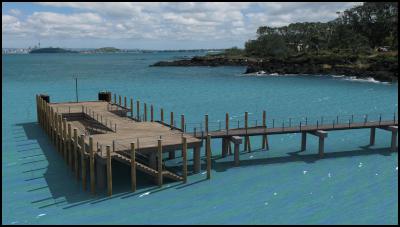New Rangitoto wharf to enhance island experience
Media release
14 September
2012
New Rangitoto
wharf to enhance island
experience
Work begins next
week on a 14-month construction project to provide a much
safer, durable wharf for the 100,000 visitors to Rangitoto
and Motutapu each year.
The new $5.5m wharf will have a lifespan of at least 100 years, and is designed to be usable in all sailable weather (including prevailing winds), and by more vessels at once, thanks to its double landing design.

The wharf-head’s positioning will significantly reduce the number of ferries forced to travel further on to Islington Bay Wharf in adverse weather.
In order to keep disruption to passengers to a minimum, the wharf will be closed for a period of approximately a month at the start of the construction period, and another week towards the end of the project.
A crane is planned to arrive on site on Tuesday September 18, and the existing wharf will be closed from Monday September 17 until at least October 19, to enable major construction work for the new wharf. Over that period the Fullers ferry will be diverted to the Islington Bay wharf with all sailings and the Volcanic Explorer Tour on the island operating as normal.
Rangitoto is the largest and youngest volcano in the Auckland region with geology, history, plants and ecosystems of national and international significance.
Jonathan Miles, Auckland Area Manager for the Department of Conservation (DOC), says that with over 1.4 million people living on the doorstep of Rangitoto and Motutapu, and easy access via a 25-minute ferry from downtown Auckland, the island fulfils a crucial role in DOC’s efforts to promote conservation, ecology and recreation.
“There’s increased interest in Rangitoto and Motutapu, with visitors eager to experience these islands now we’ve removed animal pests such as rats, stoats and possums enabling us to release endangered native birds on the islands.”
“We’ve ensured the new wharf caters for further increases in visitor numbers, as well as variable vessel sizes and schedules.”
Agencies with an interest in the islands, including DOC and Auckland Council’s ATEED (Auckland Tourism, Events and Economic Development), plan a greater number of tourism and visitors experiences.
For
information regarding the Fuller ferry sailings to the
island during the wharf upgrade period, please visit
www.fullers.co.nz
ENDS
Background
The
old wharf
The current wooden wharf opened in 1958 and has been repeatedly modified over the years to accommodate larger vessels and visitor numbers. The size of vessels using the existing wharf substantially exceeds its original intention, and this has contributed to the wharf’s deterioration.
Ecology
Rangitoto Island is the largest, youngest and one of the least modified of about 50 volcanic cones and craters in the Auckland volcanic field. It erupted from the sea in a series of dramatic explosions around 600 years ago, and is now extinct. The island is a public reserve managed by the Department of Conservation and is famed world-wide as a botanical gem.
Visitors
Day visitors are welcome, and can explore the island via a network of tracks and roads. Rangitoto is joined to Motutapu Island by a causeway.
The summit can be reached in a two hour return walk from Rangitoto Wharf or a two and a half hour return walk from Islington Bay (approximate times). A loop track around the crater rim gives fine views of the extinct crater and the views from the summit provide 360 degree views of Auckland and the Hauraki Gulf.
Making Rangitoto and Motutapu pest free
Rangitoto and Motutapu are now pest-free islands. This follows DOC’s removal of pests including rats, stoats and possums that devastate native forest and eat the eggs and chicks of native birds. The most recent eradication programme rid Motutapu and Rangitoto of Norway rats, ship rats, stoats, mice, feral cats, rabbits and hedgehogs. In the early 1990s possums and wallabies were removed from both islands.
Getting rid of these animal pests has led to the recovery of the pohutukawa forest on Rangitoto, which is the world’s largest. Volunteers from the Motutapu Restoration Trust have planted more than 400,000 native trees on the island. This has created a home for the native wildlife that’s been released since Motutapu and Rangitoto were cleared of animal pests.
Rangitoto and Motutapu were declared pest free on August 27 last year. Since then four types of native birds have been released on the islands. These are takahe and shore plover/ tuturuatu both critically endangered. Tieke /saddleback and whiteheads/ popokatea are the other native birds released on the islands. Koura (freshwater crayfish) and red fin bullies have also been released into a stream on Motutapu.
Bellbirds (korimako) and kakariki have flown from pest-free Motuihe and Rakino islands and are breeding on Motutapu and Rangitoto now they are also pest free. Pateke and spotless crakes have also returned to Motutapu and Rangitoto.


 Gordon Campbell: On Why Leakers Are Essential To The Public Good
Gordon Campbell: On Why Leakers Are Essential To The Public Good The Tree Council: Auckland Council Notifies Plan Change 113 Notable Trees
The Tree Council: Auckland Council Notifies Plan Change 113 Notable Trees ACT New Zealand: ACT New Zealand Celebration Brunch - David Seymour's First Speech as Deputy PM
ACT New Zealand: ACT New Zealand Celebration Brunch - David Seymour's First Speech as Deputy PM NZ Police: Operation Purple | Anti-Social Road User Gathering In Levin
NZ Police: Operation Purple | Anti-Social Road User Gathering In Levin New Zealand Defence Force: The Latest Update On The HMNZS Manawanui Response
New Zealand Defence Force: The Latest Update On The HMNZS Manawanui Response NZCTU: NZCTU Release Detailed Budget 2025 Analysis
NZCTU: NZCTU Release Detailed Budget 2025 Analysis Department of Conservation: DOC Reveals Surprising Toilet Paper Stats
Department of Conservation: DOC Reveals Surprising Toilet Paper Stats


